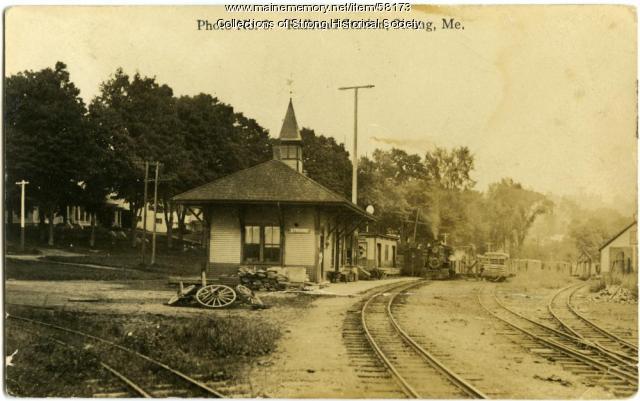Keywords: engines
Item 82263
Fire Engines at Jefferson Street Station, Waldoboro, ca. 1960
Contributed by: Waldoboro Fire Department Date: circa 1960 Location: Waldoboro Media: Photographic print
Item 16874
Hand-pump fire engine model, Portland, ca. 1850
Contributed by: Maine Historical Society Date: circa 1850 Location: Portland Media: Wood, paint
Item 32672
44 Berkeley Street, Portland, 1924
Owner in 1924: Sanders Engineering Co. Style: Colonial Revival Use: Dwelling - Two family
Item 33135
38-44 Berkeley Street, Portland, 1924
Owner in 1924: Sanders Engineering Co. Use: Dwelling - Two family
Item 151358
Contributed by: Maine Historical Society Date: 2015 Location: Biddeford Client: Engine Architect: Carol A. Wilson
Item 151759
Walch Publishing parking plan, Portland, 1991-1999
Contributed by: Maine Historical Society Date: 1991–1999 Location: Portland Client: Walch Properties Architect: Allied Architects & Engineers
Exhibit
The Waldo-Hancock Bridge is in the process of being dismantled after over 70 years of service. The Maine State Archives has a number of records related to the history of this famous bridge that are presented in this exhibition.
Exhibit
Waldoboro Fire Department's 175 Years
While the town of Waldoboro was chartered in 1773, it began organized fire protection in 1838 with a volunteer fire department and a hand pump fire engine, the Water Witch.
Site Page
New Portland: Bridging the Past to the Future - Bridges of West New Portland
"Morse who had been in the army and had engineering experience. He drew the design and ordered two cables to be made in Sheffield, England."
Site Page
New Portland: Bridging the Past to the Future - Bridges of East New Portland
"… and was designed under guidance of State Bridge Engineer Llewlyn Edwards. This is one of the most complete early concrete bridges remaining in the…"
Story
My career as a chemical engineer for S.D. Warren Paper Company
by Charles Dodge
I worked in S.D. Warren's laboratory, and developed paper coatings, like Ultracast technology
Story
Mosher family history and my career at S.D. Warren
by Abbott Mosher
My family settled the Westbrook region and I am a 4th generation paper maker at S.D. Warren.
Lesson Plan
Maine's Beneficial Bugs: Insect Sculpture Upcycle/ Recycle S.T.E.A.M Challenge
Grade Level: 3-5, 6-8
Content Area: Science & Engineering, Visual & Performing Arts
In honor of Earth Day (or any day), Students use recycled, reused, and upcycled materials to create a sculpture of a beneficial insect that lives in the state of Maine. Students use the Engineer Design Process to develop their ideas. Students use the elements and principles to analyze their prototypes and utilize interpersonal skills during peer feedback protocol to accept and give constructive feedback.
Lesson Plan
Portland History: The Portland Observatory and Thermometrics
Grade Level: 3-5, 6-8
Content Area: Science & Engineering, Social Studies
Thermometrics is a term coined by Moody to describe his weather recording activities. Included here are some cross-curricula lesson plans and activities for students to use their knowledge in science, math and social studies while acting as weather forecasters. Check out the web-sites listed in this section for information on building your own barometer and anemometer.






















